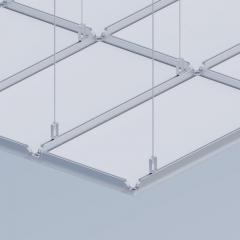
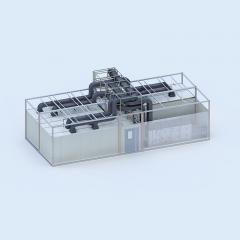
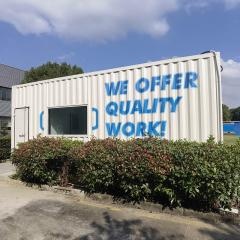
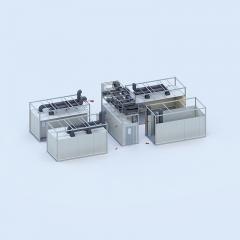
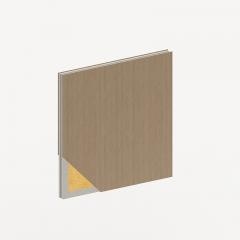
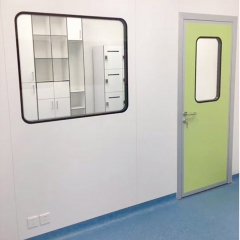
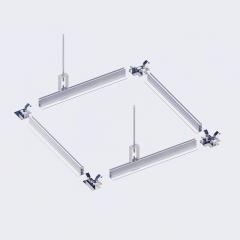
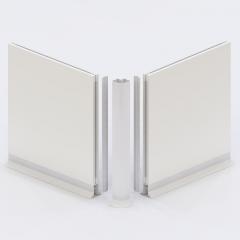
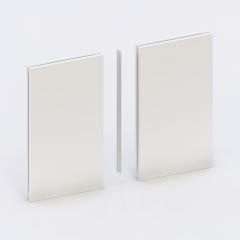
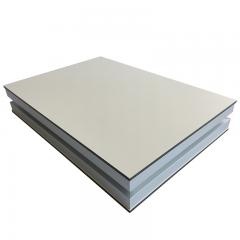
In the world of clean room technology, the right materials and design can make all the difference. At Wonclean, we are dedicated to providing high - performance solutions that enhance efficiency and reliability. As a leading clean room panel manufacturers, we offer a comprehensive range of products, including advanced HPL sandwich panels and integrated cleanroom wall system and ceiling system, designed to meet the most stringent industry standards. Clean Room Panel Manufacturers: Quality and Innovation As a top - tier clean room panel manufacturers, Wonclean is committed to delivering high - quality and innovative solutions. Our panels are designed to provide a seamless and durable barrier against contaminants, ensuring a controlled environment. Made from high - quality materials that are easy to clean and maintain, our panels offer excellent thermal insulation and fire - resistance properties. Whether you need panels for walls or ceilings, our clean room panel manufacturers ensure that every product meets the highest standards of performance and reliability. HPL Sandwich Panels:Strength and Versatility Our HPL sandwich panels are designed to provide high - performance insulation and durability. These panels are constructed with a core of high - density polyurethane (PU) sandwiched between two layers of high - pressure laminate (HPL), offering excellent thermal insulation and chemical resistance. The HPL surface is easy to clean and maintain, making it ideal for environments where hygiene is critical. Whether you need panels for walls or ceilings, our HPL sandwich panels are designed to provide the reliability and performance you need. Integrated Wall and Ceiling System: A Complete Solution At Wonclean, we offer a comprehensive solution for your clean room needs. Our cleanroom wall system and ceiling system are designed to work together seamlessly, providing a cohesive and highly effective clean room environment. The panels are engineered to provide optimal airflow and particle control, ensuring that your clean room operates at the highest level of efficiency. By integrating our wall and ceiling systems, you can achieve a clean room that meets the most stringent industry standards. Customization and Flexibility We understand that every clean room has unique requirements. That's why our products are highly customizable. From specific panel sizes to unique configurations, our team of experts works closely with you to create a clean room solution that meets your exact specifications. Our commitment to customization ensures that your clean room is not only efficient but also tailored to your specific needs and operational goals. Why Choose Wonclean? When it comes to clean room solutions, Wonclean stands out as a leader in the industry. Our combination of high - quality products, innovative design, and exceptional customer service sets us apart. By choosing Wonclean, you are investing in a partner that...
In the rapidly evolving world of clean room technology, flexibility and efficiency are becoming increasingly important. At Wonclean, we are committed to providing innovative solutions that meet these demands. Our modular clean room systems, cleanroom sandwich panels, and clean room ceiling grid are designed to offer unparalleled performance and adaptability, ensuring that your clean room operates at the highest level of efficiency. Modular Clean Room: The Key to Flexibility and Efficiency Our modular clean room systems are engineered to provide maximum flexibility and adaptability. These modular units can be easily configured and reconfigured to meet the changing needs of your facility. Whether you need to expand your clean room or adapt it to new processes, our modular design ensures that your clean room can evolve without compromising on performance. The modular approach also allows for faster installation and reduced downtime, making it an ideal solution for facilities that require quick setup and easy modification. Cleanroom Sandwich Panels: High - Performance and Versatility The cleanroom sandwich panels from Wonclean are designed to provide high - performance insulation and durability. These panels are constructed with a core of high - density polyurethane (PU) sandwiched between two layers of galvanized steel or stainless steel, offering excellent thermal insulation and fire - resistance properties. The panels are available in various sizes and configurations, allowing for easy customization to meet the specific needs of your clean room. Whether you need panels for walls, ceilings, or partitions, our cleanroom sandwich panels are designed to provide the reliability and performance you need. Clean Room Ceiling Grid: Optimal Airflow and Particle Control The clean room ceiling grid from Wonclean is a critical component in maintaining optimal airflow and particle control. This grid system is designed to integrate seamlessly with fan filter units (FFUs) and other air - handling equipment, ensuring a consistent and efficient flow of clean air throughout the room. The modular design of the grid system allows for easy installation and customization, making it simple to adapt the ceiling layout to specific facility needs. With our clean room ceiling grid, you can achieve the highest standards of cleanliness and efficiency. Customization and Flexibility At Wonclean, we understand that every clean room has unique requirements. That's why our products are designed to be highly customizable. Whether you need specific panel sizes, unique configurations, or specialized materials, our team of experts can work with you to create a clean room solution that meets your exact specifications. Our commitment to customization ensures that your clean room is not only efficient but also tailored to your specific needs. Why Choose Wonclean? When it comes to choosing a clean room supplier, Wonclean stands ou...
In the precision - driven world of clean rooms, the right HVAC system and air flow design can make all the difference. At Wonclean, we focus on delivering top - notch clean room solutions that boost efficiency and reliability. Our clean room HVAC system design and horizontal laminar air flow hood are engineered to keep your clean room running smoothly and contamination - free. Clean Room HVAC System Design: Tailored for Efficiency Our clean room HVAC system design is built to optimize air flow and maintain strict cleanliness standards. With customizable configurations, our HVAC systems can be tailored to fit any clean room size or layout. This flexibility ensures that your facility can adapt to changing needs without sacrificing performance. Whether you're expanding or upgrading, our HVAC solutions are designed to keep your clean room operating at peak efficiency. Horizontal Laminar Air Flow Hood: Precision Air Flow Control The horizontal laminar air flow hood is a cornerstone of our clean room solutions. It provides a steady, uniform stream of clean air across the work area, effectively removing contaminants and maintaining a sterile environment. Equipped with HEPA filters, this hood ensures that particles as small as 0.3 microns are captured, making it ideal for sensitive processes that demand the highest level of cleanliness. Customization to Meet Your Needs We understand that every clean room is unique. That's why our products are highly customizable. From specific HVAC system requirements to specialized air flow hood designs, our team works closely with you to create a solution that fits your exact specifications. This commitment to customization ensures that your clean room is not only efficient but also perfectly suited to your operations. One - Stop Clean Room Solutions As a trusted clean room manufacturers, Wonclean offers a comprehensive range of products and services. From initial design and engineering to installation and maintenance, we provide a one - stop solution for all your clean room needs. Our experienced team is dedicated to helping you create and maintain a clean room that meets the highest standards of cleanliness and efficiency. Choose Wonclean for Reliable Clean Room Solutions When you choose Wonclean, you're choosing a partner committed to quality and innovation. Our clean room HVAC system design and horizontal laminar air flow hood are designed to provide the reliability and flexibility you need to keep your clean room operating at its best. Invest in Wonclean and invest in a future of efficient, contamination - free clean rooms. For media inquiries, please contact: Add: No.68 LuXiang Road, Kunshan, China Email: Allen@wonclean.com Web: www.wonclean.com Tel: 0512-5780 2738
When you walk into a cutting-edge wafer fab or hyperscale data hall, your eyes are drawn to the rows of gleaming tools—not the ceiling overhead. Yet that FFU ceiling grid is quietly determining yield, uptime, and power bills for every semiconductor cleanroom supplier on the planet. At Wonclean in Kunshan, Jiangsu, we decided the ceiling deserved a louder voice. Here’s the story of how our Data center ceiling grid went from overlooked commodity to strategic advantage—and why it now ships to fabs from Austin to Austin Bay. 1. From Patchwork to Puzzle-Free Precision Traditional stick-built ceilings force teams to juggle separate rails, gaskets, FFUs, and cables. One misaligned screw and airflow uniformity plummets. Wonclean’s FFU ceiling grid arrives as a pre-engineered kit: extruded-aluminum rails with integrated power rails and T-slot channels for lighting or sensors. Installers simply “click, clip, connect.” A 500 m² zone that once took four days now goes live in six hours—without a single dropped fastener. 2. The Grid That Bends Without Breaking Node shrinks come fast; your ceiling should keep up. Our rails are rated for 250 kg/m² live load, so you can swap 1,200 m³/h FFUs for 2,000 m³/h units overnight. Need to add more tomorrow? Slide them in while production continues—zero downtime, zero tile cutting. That flexibility is why two of the top five semiconductor cleanroom suppliers specify Wonclean grids as their default build. 3. Panels Engineered for Zero Thermal Bridges Every Data center panel is a 50 mm steel/PU/steel sandwich with tongue-and-groove edges that lock into the rail to create an airtight, fire-rated envelope. Thermal conductivity: 0.022 W/m·K. Fire rating: 120 minutes. Tongue-and-groove seal integrity under 1,000 Pa differential: <0.1 % leakage. Translation: your chillers work 15 % less, and your tools stay at ±0.1 °C year-round. 4. ROI Measured in Kilowatts and Wafers A recent 5 nm ramp in Hsinchu swapped legacy gypsum-plus-grids for Wonclean’s modular kit. Power consumption dropped 14 %, commissioning time fell from 18 to 12 days, and first-pass yield climbed 2.3 %. The finance team ran the numbers: payback came in under eight months—faster than the next litho upgrade. 5. From Kunshan to the World—Fast All rails and panels are precision-machined at our 30,000 m² Kunshan facility, then flat-packed to cut freight costs by 22 %. Standard SKUs ship in seven days; custom colors or cut-outs in fourteen. And because we’re a one-stop semiconductor cleanroom supplier, you get one warranty covering grid, FFU, and panel—no finger-pointing when you need support at 2 a.m. Ready to see the ceiling that fabs are whispering about? Download BIM models, watch the 90-second install video, or book a live demo at wonclean.com.
In the world of clean room technology, innovation and efficiency are key. “Wonclean”, a leading “China clean room” supplier, is at the forefront of this revolution, offering cutting-edge solutions that enhance performance and simplify construction. From “clean room wall systems” to “clean room ceiling panels”, Wonclean's products are designed to meet the highest standards of cleanliness and functionality。 Clean Room Wall Systems: The Foundation of Efficiency Wonclean's “clean room wall systems” are engineered to provide a seamless and durable barrier against contaminants. These systems are designed with precision, ensuring that every joint and connection is airtight. The walls are constructed using high-quality materials that are easy to clean and maintain, making them ideal for environments where hygiene is critical. Whether it's a pharmaceutical lab or an electronics manufacturing facility, Wonclean's “clean room wall systems” offer the reliability and performance needed to maintain a controlled environment. Clean Room Ceiling Panels: The Key to Air Quality The “clean room ceiling panels” from Wonclean are a testament to the company's commitment to innovation. These panels are designed to integrate seamlessly with ventilation systems, ensuring optimal airflow and particle control. Made from advanced materials, the panels are lightweight yet robust, providing excellent thermal insulation and noise reduction. The modular design allows for easy installation and customization, making it simple to adapt the ceiling layout to specific facility needs. With Wonclean's “clean room ceiling panels”, maintaining high air quality has never been easier. Sandwich Panels Suppliers: Quality and Versatility As a trusted “sandwich panels suppliers”, Wonclean offers a range of high-performance sandwich panels that combine multiple layers of materials to provide superior insulation and strength. These panels are ideal for a variety of applications, from clean room ceilings to walls, and are designed to meet the stringent requirements of modern clean room environments. The panels are available in various sizes and configurations, making them a versatile solution for any project. With their excellent thermal and acoustic properties, Wonclean's sandwich panels are a key component in creating efficient and comfortable clean room spaces. China Clean Room Solutions: A Global Standard Wonclean's “China clean room” solutions are setting a new global standard for clean room design and construction. By leveraging advanced technology and high-quality materials, Wonclean ensures that each clean room project meets the highest standards of cleanliness and efficiency. The company's comprehensive range of products and services, from wall systems to ceiling panels, provides a one-stop solution for businesses looking to create state-of-the-art clean room facilities. With a focus on innovation and customer satisfaction, Wonclean continues to lead the industry in delivering ...
In the high - stakes world of clean rooms, particularly within data centers, the Data center ceiling plays a pivotal role in maintaining optimal performance. The ceiling isn't just a structural element; it's an integral part of the clean room's ecosystem. A well - designed “Data center ceiling” can significantly influence airflow, particle control, and overall operational efficiency. But have you ever stopped to consider whether your current ceiling setup is truly meeting the demands of your clean room environment? The Clean room ceiling panels are the building blocks of a successful clean room ceiling. These panels must meet stringent standards for air permeability, durability, and ease of cleaning. High - quality Clean room ceiling panels not only help maintain the required air pressure differential but also minimize particle shedding, which is crucial in preventing contamination in data center environments. When selecting “Clean room ceiling panels”, factors such as material composition, thickness, and compatibility with the existing ventilation system should be carefully evaluated to ensure they provide the best possible performance. The Clean room ceiling grid system serves as the framework that holds everything together. A robust and well - engineered Clean room ceiling grid system ensures the stability and proper alignment of the ceiling panels. It also facilitates easy installation, maintenance, and replacement of panels as needed. The grid system's design can impact the overall aesthetics of the clean room while playing a key role in supporting the weight of the panels and any additional components, such as lighting fixtures or air - handling units, that may be mounted on the ceiling. Beyond the ceiling, the Clean room partition wall is another critical component in defining and maintaining clean room spaces. The “Clean room partition wall” helps create distinct zones within the data center, allowing for better control of environmental conditions and personnel movement. It should possess excellent sealing properties to prevent the ingress of contaminants from adjacent areas and be constructed from materials that resist microbial growth and are easy to sanitize. The placement and design of “Clean room partition walls” can also contribute to the efficient layout of the data center, optimizing workflow and minimizing cross - contamination risks. Finally, the Clean room wall systems form the protective envelope of the clean room. They must provide a barrier against external contaminants while maintaining structural integrity. “Clean room wall systems” come in various materials and configurations, each offering different advantages in terms of thermal insulation, impact resistance, and ease of maintenance. Selecting the appropriate “Clean room wall systems” is essential to ensure they complement the ceiling and partition walls in creating a cohesive and effective clean room environment that meets the specific req...